Database Access with Azure PostgreSQL and MySQL
Teleport can provide secure access to Azure PostgreSQL or MySQL via the Teleport Database Service. This allows for fine-grained access control through Teleport's RBAC.
In this guide, you will:
- Configure an Azure PostgreSQL or MySQL database with IAM authentication.
- Join the Azure PostgreSQL or MySQL database to your Teleport cluster.
- Connect to the Azure PostgreSQL or MySQL database via the Teleport Database Service.
Database auto-discovery for Azure PostgreSQL/MySQL flexible servers is available starting from
Teleport 12.0.
- Self-Hosted
- Teleport Enterprise Cloud
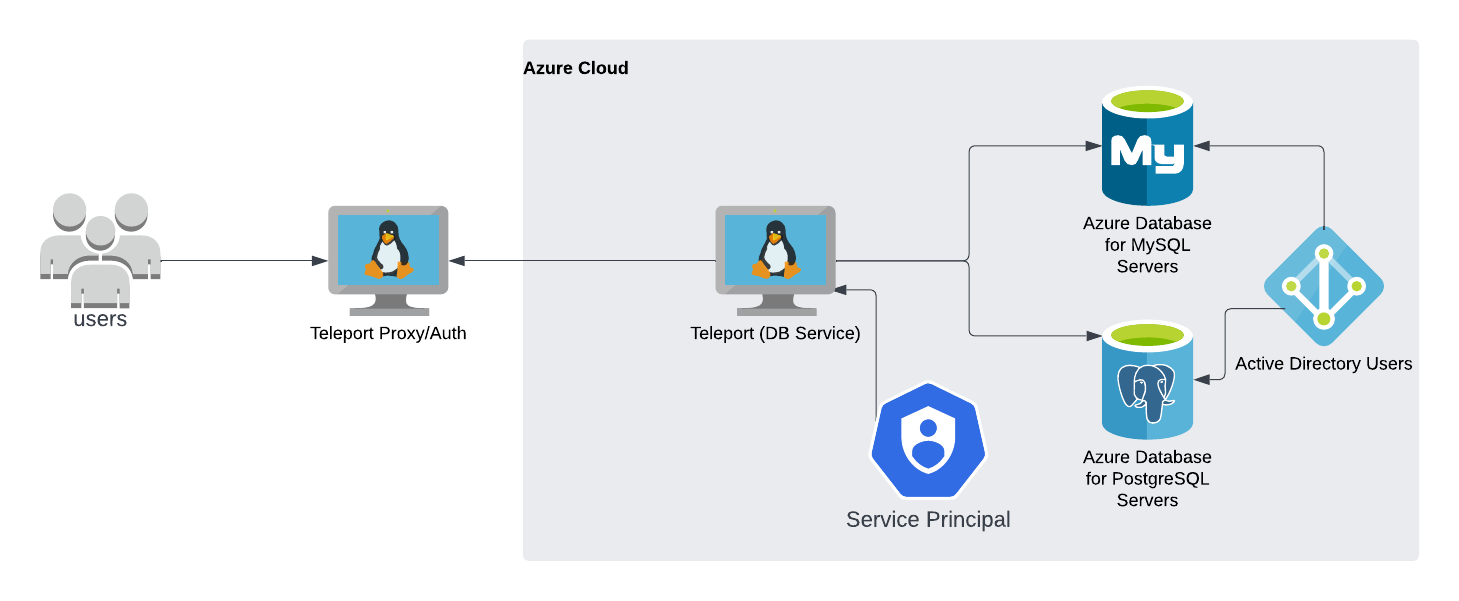
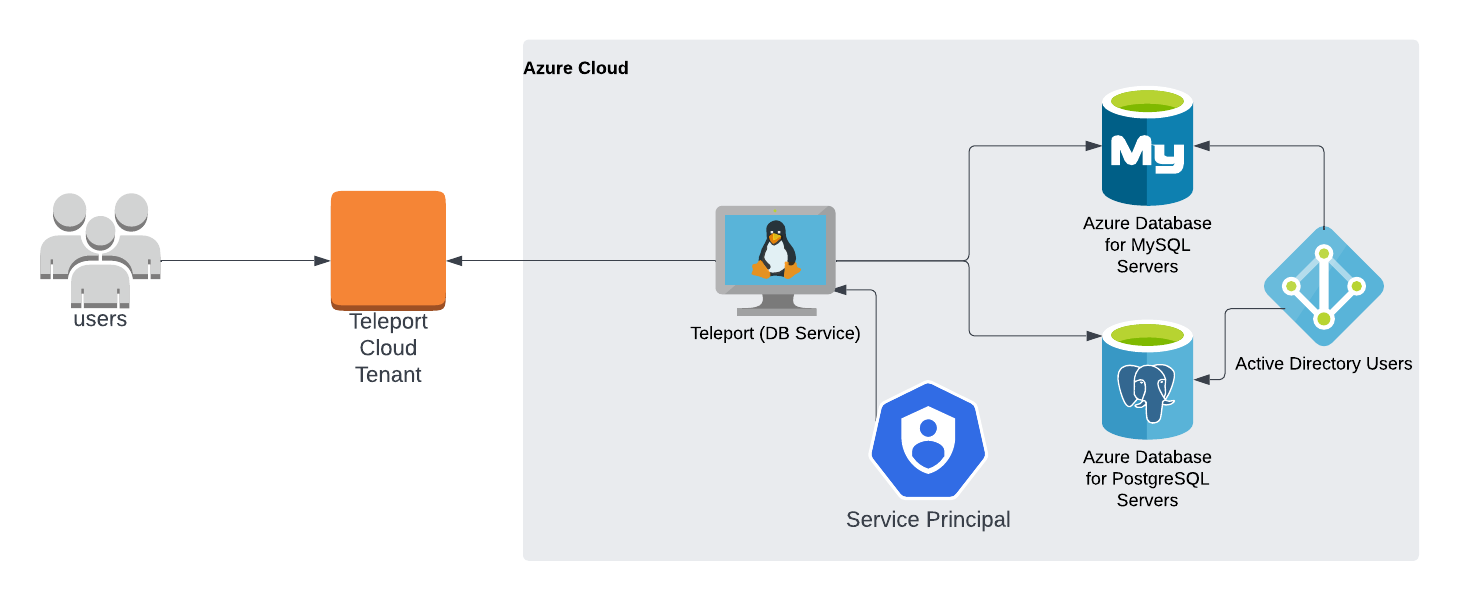
Prerequisites
-
A running Teleport cluster version 14.3.33 or above. If you want to get started with Teleport, sign up for a free trial or set up a demo environment.
-
The
tctladmin tool andtshclient tool.Visit Installation for instructions on downloading
tctlandtsh.
- Deployed Azure Database for PostgreSQL or MySQL server.
- Azure Active Directory administrative privileges.
- A host, e.g., an Azure VM instance, where you will run the Teleport Database Service.
- To check that you can connect to your Teleport cluster, sign in with
tsh login, then verify that you can runtctlcommands using your current credentials.tctlis supported on macOS and Linux machines. For example:If you can connect to the cluster and run the$ tsh login --proxy=teleport.example.com [email protected]
$ tctl status
# Cluster teleport.example.com
# Version 14.3.33
# CA pin sha256:abdc1245efgh5678abdc1245efgh5678abdc1245efgh5678abdc1245efgh5678tctl statuscommand, you can use your current credentials to run subsequenttctlcommands from your workstation. If you host your own Teleport cluster, you can also runtctlcommands on the computer that hosts the Teleport Auth Service for full permissions.
Step 1/5. Install the Teleport Database Service
The Database Service requires a valid join token to join your Teleport cluster.
Run the following tctl command and save the token output in /tmp/token
on the server that will run the Database Service:
$ tctl tokens add --type=db --format=text
abcd123-insecure-do-not-use-this
Install Teleport on the host where you will run the Teleport Database Service:
Select an edition, then follow the instructions for that edition to install Teleport.
- Teleport Community Edition
- Teleport Enterprise
- Teleport Enterprise Cloud
The following command updates the repository for the package manager on the local operating system and installs the provided Teleport version:
$ curl https://cdn.teleport.dev/install-v14.3.33.sh | bash -s 14.3.33
- Debian 9+/Ubuntu 16.04+ (apt)
- Amazon Linux 2/RHEL 7 (yum)
- Amazon Linux 2/RHEL 7 (zypper)
- Amazon Linux 2023/RHEL 8+ (dnf)
- SLES 12 SP5+ and 15 SP5+ (zypper)
- Tarball
# Download Teleport's PGP public key
$ sudo curl https://apt.releases.teleport.dev/gpg \
-o /usr/share/keyrings/teleport-archive-keyring.asc
# Source variables about OS version
$ source /etc/os-release
# Add the Teleport APT repository for v14. You'll need to update this
# file for each major release of Teleport.
$ echo "deb [signed-by=/usr/share/keyrings/teleport-archive-keyring.asc] \
https://apt.releases.teleport.dev/${ID?} ${VERSION_CODENAME?} stable/v14" \
| sudo tee /etc/apt/sources.list.d/teleport.list > /dev/null
$ sudo apt-get update
$ sudo apt-get install teleport-ent
For FedRAMP/FIPS-compliant installations, install the teleport-ent-fips package instead:
$ sudo apt-get install teleport-ent-fips
# Source variables about OS version
$ source /etc/os-release
# Add the Teleport YUM repository for v14. You'll need to update this
# file for each major release of Teleport.
# First, get the major version from $VERSION_ID so this fetches the correct
# package version.
$ VERSION_ID=$(echo $VERSION_ID | grep -Eo "^[0-9]+")
$ sudo yum install -y yum-utils
$ sudo yum-config-manager --add-repo "$(rpm --eval "https://yum.releases.teleport.dev/$ID/$VERSION_ID/Teleport/%{_arch}/stable/v14/teleport.repo")"
$ sudo yum install teleport-ent
#
# Tip: Add /usr/local/bin to path used by sudo (so 'sudo tctl users add' will work as per the docs)
# echo "Defaults secure_path = /sbin:/bin:/usr/sbin:/usr/bin:/usr/local/bin" > /etc/sudoers.d/secure_path
For FedRAMP/FIPS-compliant installations, install the teleport-ent-fips package instead:
$ sudo yum install teleport-ent-fips
# Source variables about OS version
$ source /etc/os-release
# Add the Teleport Zypper repository for v14. You'll need to update this
# file for each major release of Teleport.
# First, get the OS major version from $VERSION_ID so this fetches the correct
# package version.
$ VERSION_ID=$(echo $VERSION_ID | grep -Eo "^[0-9]+")
# Use zypper to add the teleport RPM repo
$ sudo zypper addrepo --refresh --repo $(rpm --eval "https://zypper.releases.teleport.dev/$ID/$VERSION_ID/Teleport/%{_arch}/stable/cloud/teleport-zypper.repo")
$ sudo yum install teleport-ent
#
# Tip: Add /usr/local/bin to path used by sudo (so 'sudo tctl users add' will work as per the docs)
# echo "Defaults secure_path = /sbin:/bin:/usr/sbin:/usr/bin:/usr/local/bin" > /etc/sudoers.d/secure_path
For FedRAMP/FIPS-compliant installations, install the teleport-ent-fips package instead:
$ sudo yum install teleport-ent-fips
# Source variables about OS version
$ source /etc/os-release
# Add the Teleport YUM repository for v14. You'll need to update this
# file for each major release of Teleport.
# First, get the major version from $VERSION_ID so this fetches the correct
# package version.
$ VERSION_ID=$(echo $VERSION_ID | grep -Eo "^[0-9]+")
# Use the dnf config manager plugin to add the teleport RPM repo
$ sudo dnf config-manager --add-repo "$(rpm --eval "https://yum.releases.teleport.dev/$ID/$VERSION_ID/Teleport/%{_arch}/stable/v14/teleport.repo")"
# Install teleport
$ sudo dnf install teleport-ent
# Tip: Add /usr/local/bin to path used by sudo (so 'sudo tctl users add' will work as per the docs)
# echo "Defaults secure_path = /sbin:/bin:/usr/sbin:/usr/bin:/usr/local/bin" > /etc/sudoers.d/secure_path
For FedRAMP/FIPS-compliant installations, install the teleport-ent-fips package instead:
$ sudo dnf install teleport-ent-fips
# Source variables about OS version
$ source /etc/os-release
# Add the Teleport Zypper repository.
# First, get the OS major version from $VERSION_ID so this fetches the correct
# package version.
$ VERSION_ID=$(echo $VERSION_ID | grep -Eo "^[0-9]+")
# Use Zypper to add the teleport RPM repo
$ sudo zypper addrepo --refresh --repo $(rpm --eval "https://zypper.releases.teleport.dev/$ID/$VERSION_ID/Teleport/%{_arch}/stable/v14/teleport-zypper.repo")
# Install teleport
$ sudo zypper install teleport-ent
For FedRAMP/FIPS-compliant installations, install the teleport-ent-fips package instead:
$ sudo zypper install teleport-ent-fips
In the example commands below, update $SYSTEM_ARCH with the appropriate
value (amd64, arm64, or arm). All example commands using this variable
will update after one is filled out.
$ curl https://cdn.teleport.dev/teleport-ent-v14.3.33-linux-$SYSTEM_ARCH-bin.tar.gz.sha256
# <checksum> <filename>
$ curl -O https://cdn.teleport.dev/teleport-ent-v14.3.33-linux-$SYSTEM_ARCH-bin.tar.gz
$ shasum -a 256 teleport-ent-v14.3.33-linux-$SYSTEM_ARCH-bin.tar.gz
# Verify that the checksums match
$ tar -xvf teleport-ent-v14.3.33-linux-$SYSTEM_ARCH-bin.tar.gz
$ cd teleport-ent
$ sudo ./install
For FedRAMP/FIPS-compliant installations of Teleport Enterprise, package URLs will be slightly different:
$ curl https://cdn.teleport.dev/teleport-ent-v14.3.33-linux-$SYSTEM_ARCH-fips-bin.tar.gz.sha256
# <checksum> <filename>
$ curl -O https://cdn.teleport.dev/teleport-ent-v14.3.33-linux-$SYSTEM_ARCH-fips-bin.tar.gz
$ shasum -a 256 teleport-ent-v14.3.33-linux-$SYSTEM_ARCH-fips-bin.tar.gz
# Verify that the checksums match
$ tar -xvf teleport-ent-v14.3.33-linux-$SYSTEM_ARCH-fips-bin.tar.gz
$ cd teleport-ent
$ sudo ./install
OS repository channels
The following channels are available for APT, YUM, and Zypper repos. They may be used in place of
stable/v14 anywhere in the Teleport documentation.
| Channel name | Description |
|---|---|
stable/<major> | Receives releases for the specified major release line, i.e. v14 |
stable/cloud | Rolling channel that receives releases compatible with current Cloud version |
stable/rolling | Rolling channel that receives all published Teleport releases |
- Debian 9+/Ubuntu 16.04+ (apt)
- Amazon Linux 2/RHEL 7/CentOS 7 (yum)
- Amazon Linux 2023/RHEL 8+ (dnf)
- SLES 12 SP5+ and 15 SP5+ (zypper)
Add the Teleport repository to your repository list:
# Download Teleport's PGP public key
$ sudo curl https://apt.releases.teleport.dev/gpg \
-o /usr/share/keyrings/teleport-archive-keyring.asc
# Source variables about OS version
$ source /etc/os-release
# Add the Teleport APT repository for cloud.
$ echo "deb [signed-by=/usr/share/keyrings/teleport-archive-keyring.asc] \
https://apt.releases.teleport.dev/${ID?} ${VERSION_CODENAME?} stable/cloud" \
| sudo tee /etc/apt/sources.list.d/teleport.list > /dev/null
# Provide your Teleport domain to query the latest compatible Teleport version
$ export TELEPORT_DOMAIN=example.teleport.com
$ export TELEPORT_VERSION="$(curl https://$TELEPORT_DOMAIN/v1/webapi/automaticupgrades/channel/default/version | sed 's/v//')"
# Update the repo and install Teleport and the Teleport updater
$ sudo apt-get update
$ sudo apt-get install "teleport-ent=$TELEPORT_VERSION" teleport-ent-updater
# Source variables about OS version
$ source /etc/os-release
# Add the Teleport YUM repository for cloud.
# First, get the OS major version from $VERSION_ID so this fetches the correct
# package version.
$ VERSION_ID=$(echo $VERSION_ID | grep -Eo "^[0-9]+")
$ sudo yum install -y yum-utils
$ sudo yum-config-manager --add-repo "$(rpm --eval "https://yum.releases.teleport.dev/$ID/$VERSION_ID/Teleport/%{_arch}/stable/cloud/teleport-yum.repo")"
# Provide your Teleport domain to query the latest compatible Teleport version
$ export TELEPORT_DOMAIN=example.teleport.com
$ export TELEPORT_VERSION="$(curl https://$TELEPORT_DOMAIN/v1/webapi/automaticupgrades/channel/default/version | sed 's/v//')"
# Install Teleport and the Teleport updater
$ sudo yum install "teleport-ent-$TELEPORT_VERSION" teleport-ent-updater
# Tip: Add /usr/local/bin to path used by sudo (so 'sudo tctl users add' will work as per the docs)
# echo "Defaults secure_path = /sbin:/bin:/usr/sbin:/usr/bin:/usr/local/bin" > /etc/sudoers.d/secure_path
# Source variables about OS version
$ source /etc/os-release
# Add the Teleport YUM repository for cloud.
# First, get the OS major version from $VERSION_ID so this fetches the correct
# package version.
$ VERSION_ID=$(echo $VERSION_ID | grep -Eo "^[0-9]+")
# Use the dnf config manager plugin to add the teleport RPM repo
$ sudo dnf config-manager --add-repo "$(rpm --eval "https://yum.releases.teleport.dev/$ID/$VERSION_ID/Teleport/%{_arch}/stable/cloud/teleport-yum.repo")"
# Provide your Teleport domain to query the latest compatible Teleport version
$ export TELEPORT_DOMAIN=example.teleport.com
$ export TELEPORT_VERSION="$(curl https://$TELEPORT_DOMAIN/v1/webapi/automaticupgrades/channel/default/version | sed 's/v//')"
# Install Teleport and the Teleport updater
$ sudo dnf install "teleport-ent-$TELEPORT_VERSION" teleport-ent-updater
# Tip: Add /usr/local/bin to path used by sudo (so 'sudo tctl users add' will work as per the docs)
# echo "Defaults secure_path = /sbin:/bin:/usr/sbin:/usr/bin:/usr/local/bin" > /etc/sudoers.d/secure_path
# Source variables about OS version
$ source /etc/os-release
# Add the Teleport Zypper repository for cloud.
# First, get the OS major version from $VERSION_ID so this fetches the correct
# package version.
$ VERSION_ID=$(echo $VERSION_ID | grep -Eo "^[0-9]+")
# Use Zypper to add the teleport RPM repo
$ sudo zypper addrepo --refresh --repo $(rpm --eval "https://zypper.releases.teleport.dev/$ID/$VERSION_ID/Teleport/%{_arch}/stable/cloud/teleport-zypper.repo")
# Provide your Teleport domain to query the latest compatible Teleport version
$ export TELEPORT_DOMAIN=example.teleport.com
$ export TELEPORT_VERSION="$(curl https://$TELEPORT_DOMAIN/v1/webapi/automaticupgrades/channel/default/version | sed 's/v//')"
# Install Teleport and the Teleport updater
$ sudo zypper install "teleport-ent-$TELEPORT_VERSION" teleport-ent-updater
OS repository channels
The following channels are available for APT, YUM, and Zypper repos. They may be used in place of
stable/v14 anywhere in the Teleport documentation.
| Channel name | Description |
|---|---|
stable/<major> | Receives releases for the specified major release line, i.e. v14 |
stable/cloud | Rolling channel that receives releases compatible with current Cloud version |
stable/rolling | Rolling channel that receives all published Teleport releases |
Is my Teleport instance compatible with Teleport Enterprise Cloud?
Before installing a teleport binary with a version besides v16,
read our compatibility rules to ensure that the binary is compatible with
Teleport Enterprise Cloud.
Teleport uses Semantic Versioning. Version numbers
include a major version, minor version, and patch version, separated by dots.
When running multiple teleport binaries within a cluster, the following rules
apply:
- Patch and minor versions are always compatible, for example, any 8.0.1 component will work with any 8.0.3 component and any 8.1.0 component will work with any 8.3.0 component.
- Servers support clients that are one major version behind, but do not support
clients that are on a newer major version. For example, an 8.x.x Proxy Service
instance is compatible with 7.x.x agents and 7.x.x
tsh, but we don't guarantee that a 9.x.x agent will work with an 8.x.x Proxy Service instance. This also means you must not attempt to upgrade from 6.x.x straight to 8.x.x. You must upgrade to 7.x.x first. - Proxy Service instances and agents do not support Auth Service instances that
are on an older major version, and will fail to connect to older Auth Service
instances by default. You can override version checks by passing
--skip-version-checkwhen starting agents and Proxy Service instances.
Create the Database Service configuration.
- PostgreSQL
- MySQL
- PostgreSQL and MySQL
-
Specify the region for your database(s) in
--azure-postgres-discovery. -
Replace the
--proxyvalue with your Teleport proxy address or Teleport cloud URI (e.g.mytenant.teleport.sh:443):$ sudo teleport db configure create \
-o file \
--proxy=teleport.example.com:443 \
--token=/tmp/token \
--azure-postgres-discovery=eastus
-
Specify the region for your database(s) in
--azure-mysql-discovery. -
Replace the
--proxyvalue with your Teleport proxy address or Teleport cloud URI (e.g.mytenant.teleport.sh:443):$ sudo teleport db configure create \
-o file \
--proxy=teleport.example.com:443 \
--token=/tmp/token \
--azure-mysql-discovery=eastus
Run the following command on your Database Service host:
$ sudo teleport db configure create \
-o file \
--proxy=teleport.example.com:443 \
--token=/tmp/token \
--azure-mysql-discovery=eastus \
--azure-postgres-discovery=eastus
This will create two types entities in teleport.yaml, one for each database
type. This is useful if you want different regions, tags, or labels for each
database type.
Alternatively, you can edit teleport.yaml to include both database types in a
single entry:
db_service:
azure:
- types: ["mysql", "postgres"]
...
This command will generate a Database Service configuration with Azure MySQL/Postgres
database auto-discovery enabled in the eastus region and place it at the
/etc/teleport.yaml location.
Create a Teleport role
On your workstation logged in to your Teleport cluster with tsh, define a new
role to provide access to your Azure database. Create a file called azure-database-role.yaml with the following content:
version: v7
kind: role
metadata:
name: azure-database-access
spec:
allow:
db_labels:
'engine':
- "Microsoft.DBforMySQL/servers"
- "Microsoft.DBforMySQL/flexibleServers"
- "Microsoft.DBforPostgreSQL/servers"
- "Microsoft.DBforPostgreSQL/flexibleServers"
db_names:
- '*'
db_users:
- teleport
| Flag | Description |
|---|---|
--db-users | List of database usernames the user will be allowed to use when connecting to the databases. A wildcard allows any user. |
--db-names | List of logical databases (aka schemas) the user will be allowed to connect to within a database server. A wildcard allows any database. |
--db-labels | List of labels assigned to the database the user will be able to access. A wildcard entry allows any database. |
Save this file and apply it to your Teleport cluster:
$ tctl create -f azure-database-role.yaml
role 'azure-database-role.yaml' has been created
Assign the azure-database-access role to your Teleport user by running the appropriate
commands for your authentication provider:
- Local User
- GitHub
- SAML
- OIDC
-
Retrieve your local user's configuration resource:
$ tctl get users/$(tsh status -f json | jq -r '.active.username') > out.yaml -
Edit
out.yaml, addingazure-database-accessto the list of existing roles:roles:
- access
- auditor
- editor
+ - azure-database-access -
Apply your changes:
$ tctl create -f out.yaml -
Sign out of the Teleport cluster and sign in again to assume the new role.
-
Retrieve your
githubauthentication connector:$ tctl get github/github --with-secrets > github.yamlNote that the
--with-secretsflag adds the value ofspec.signing_key_pair.private_keyto thegithub.yamlfile. Because this key contains a sensitive value, you should remove the github.yaml file immediately after updating the resource. -
Edit
github.yaml, addingazure-database-accessto theteams_to_rolessection.The team you should map to this role depends on how you have designed your organization's role-based access controls (RBAC). However, the team must include your user account and should be the smallest team possible within your organization.
Here is an example:
teams_to_roles:
- organization: octocats
team: admins
roles:
- access
+ - azure-database-access -
Apply your changes:
$ tctl create -f github.yaml -
Sign out of the Teleport cluster and sign in again to assume the new role.
-
Retrieve your
samlconfiguration resource:$ tctl get --with-secrets saml/mysaml > saml.yamlNote that the
--with-secretsflag adds the value ofspec.signing_key_pair.private_keyto thesaml.yamlfile. Because this key contains a sensitive value, you should remove the saml.yaml file immediately after updating the resource. -
Edit
saml.yaml, addingazure-database-accessto theattributes_to_rolessection.The attribute you should map to this role depends on how you have designed your organization's role-based access controls (RBAC). However, the group must include your user account and should be the smallest group possible within your organization.
Here is an example:
attributes_to_roles:
- name: "groups"
value: "my-group"
roles:
- access
+ - azure-database-access -
Apply your changes:
$ tctl create -f saml.yaml -
Sign out of the Teleport cluster and sign in again to assume the new role.
-
Retrieve your
oidcconfiguration resource:$ tctl get oidc/myoidc --with-secrets > oidc.yamlNote that the
--with-secretsflag adds the value ofspec.signing_key_pair.private_keyto theoidc.yamlfile. Because this key contains a sensitive value, you should remove the oidc.yaml file immediately after updating the resource. -
Edit
oidc.yaml, addingazure-database-accessto theclaims_to_rolessection.The claim you should map to this role depends on how you have designed your organization's role-based access controls (RBAC). However, the group must include your user account and should be the smallest group possible within your organization.
Here is an example:
claims_to_roles:
- name: "groups"
value: "my-group"
roles:
- access
+ - azure-database-access -
Apply your changes:
$ tctl create -f oidc.yaml -
Sign out of the Teleport cluster and sign in again to assume the new role.
Step 3/6. Configure Azure service principal
To authenticate with PostgreSQL or MySQL databases, Teleport Database Service needs to obtain access tokens from Azure AD.
There are a couple of ways for the Teleport Database Service to access Azure resources:
- The Database Service can run on an Azure VM with attached managed identity. This is the recommended way of deploying the Database Service in production since it eliminates the need to manage Azure credentials.
- The Database Service can be registered as an Azure AD application (via AD's "App registrations") and configured with its credentials. This is only recommended for development and testing purposes since it requires Azure credentials to be present in the Database Service's environment.
- Using managed identity
- Using app registrations
Go to the Managed Identities page in your Azure portal and click Create to create a new user-assigned managed identity:

Pick a name and resource group for the new identity and create it:
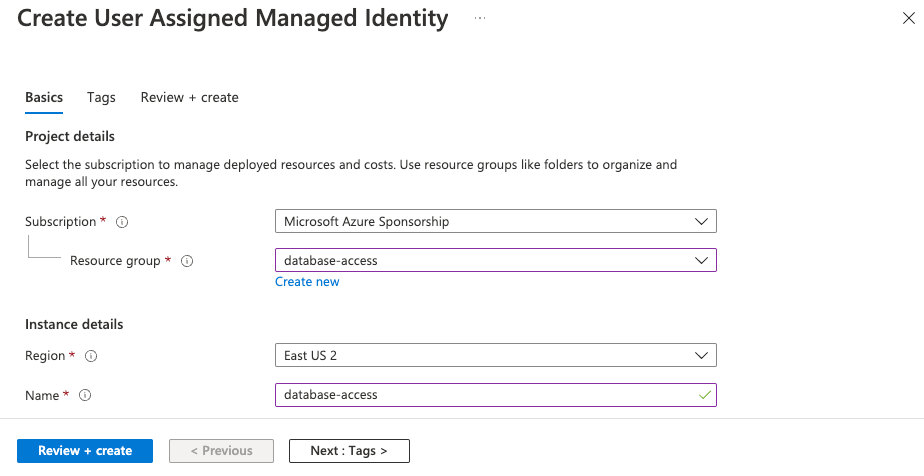
Take note of the created identity's Client ID:
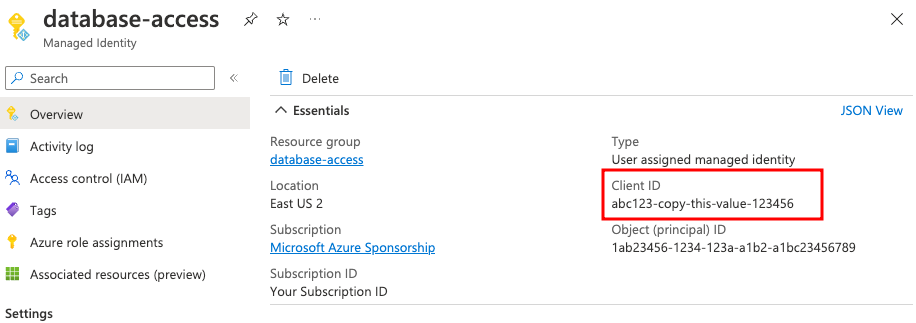
Next, navigate to the Azure VM that will run your Database Service instance and add the identity you've just created to it:
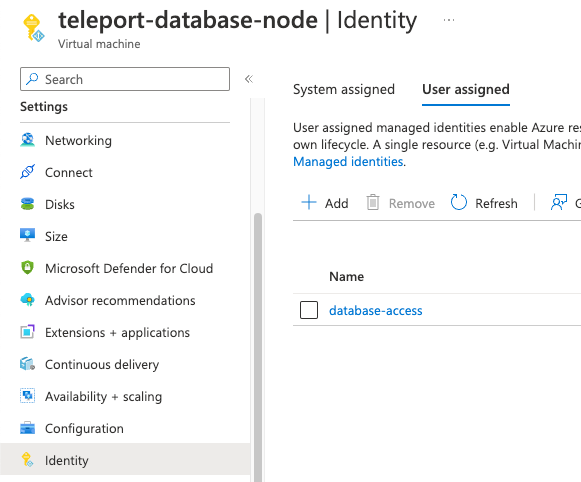
Attach this identity to all Azure VMs that will be running the Database Service.
Registering the Database Service as Azure AD application is suitable for test and development scenarios, or if your Database Service does not run on an Azure VM. For production scenarios prefer to use the managed identity approach.
Go the the App registrations page of your Azure Active Directory and click on New registration:
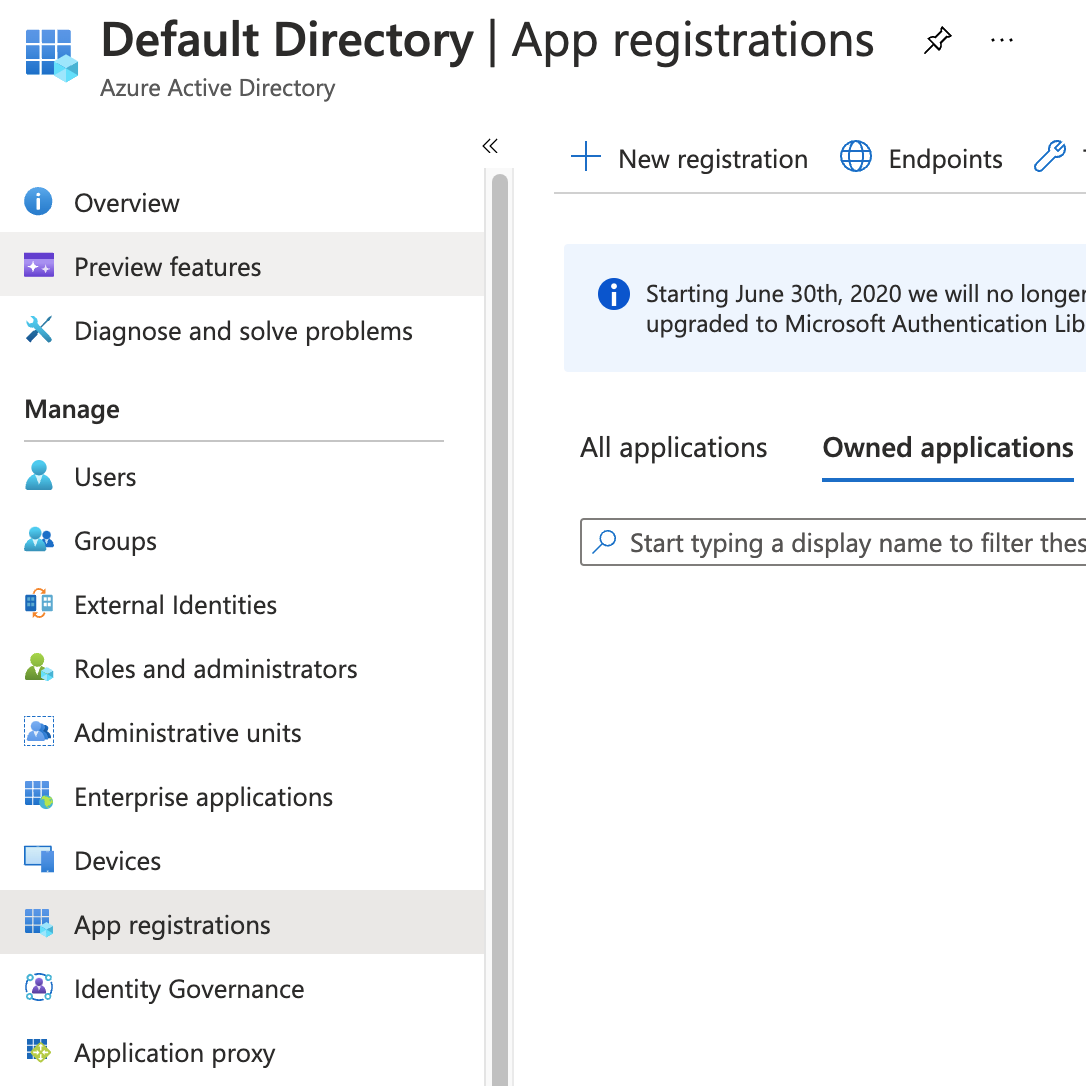
Pick a name (e.g. DatabaseService) and register a new application. Once the app has been created, take note of its Application (client) ID and click on Add a certificate or secret:

Create a new client secret that the Database Service agent will use to authenticate with the Azure API:

The Teleport Database Service uses Azure SDK's default credential provider chain to look for credentials. Refer to Azure SDK Authorization to pick a method suitable for your use-case. For example, to use environment-based authentication with a client secret, the Database Service should have the following environment variables set:
export AZURE_TENANT_ID=
export AZURE_CLIENT_ID=
export AZURE_CLIENT_SECRET=
Step 4/6. Configure IAM permissions for Teleport
Create a custom role
Teleport needs Azure IAM permissions to discover and register MySQL and PostgreSQL databases. Create a role with assignable scope(s) that include all databases that Teleport should discover. For example:
{
"properties": {
"roleName": "TeleportDiscovery",
"description": "Allows Teleport to discover MySQL and PostgreSQL databases",
"assignableScopes": [
"/subscriptions/11111111-2222-3333-4444-555555555555"
],
"permissions": [
{
"actions": [
"Microsoft.DBforMySQL/servers/read",
"Microsoft.DBforPostgreSQL/servers/read",
"Microsoft.DBforMySQL/flexibleServers/read",
"Microsoft.DBforPostgreSQL/flexibleServers/read"
],
"notActions": [],
"dataActions": [],
"notDataActions": []
}
]
}
}
This role definition allows Teleport to discover MySQL and PostgreSQL databases, but Teleport only needs permissions for the database types you have. The assignable scopes include a subscription, so the role can be assigned at any resource scope within that subscription, or assigned using the subscription scope itself.
Custom roles, unlike Azure built-in roles, can not have a root assignable scope. The highest assignable scope that can be used in a custom role is subscription scope. Using a management group scope is currently an Azure preview feature, and only allows for a single management group in the "assignableScopes" of a role definition. See Azure RBAC custom roles for more information.
Go to the Subscriptions page and select a subscription.
Click on Access control (IAM) in the subscription and select Add > Add custom role:
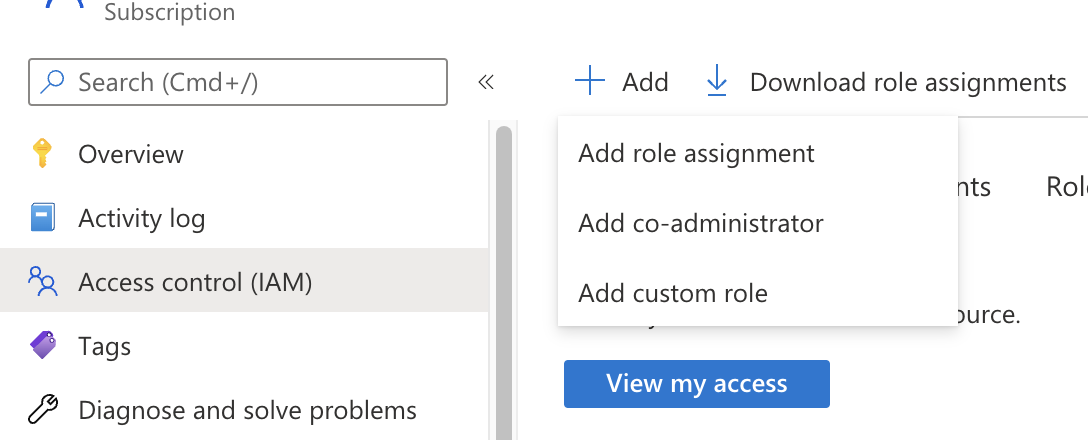
In the custom role creation page, click the JSON tab and click Edit, then paste the JSON example and replace the subscription in "assignableScopes" with your own subscription id:
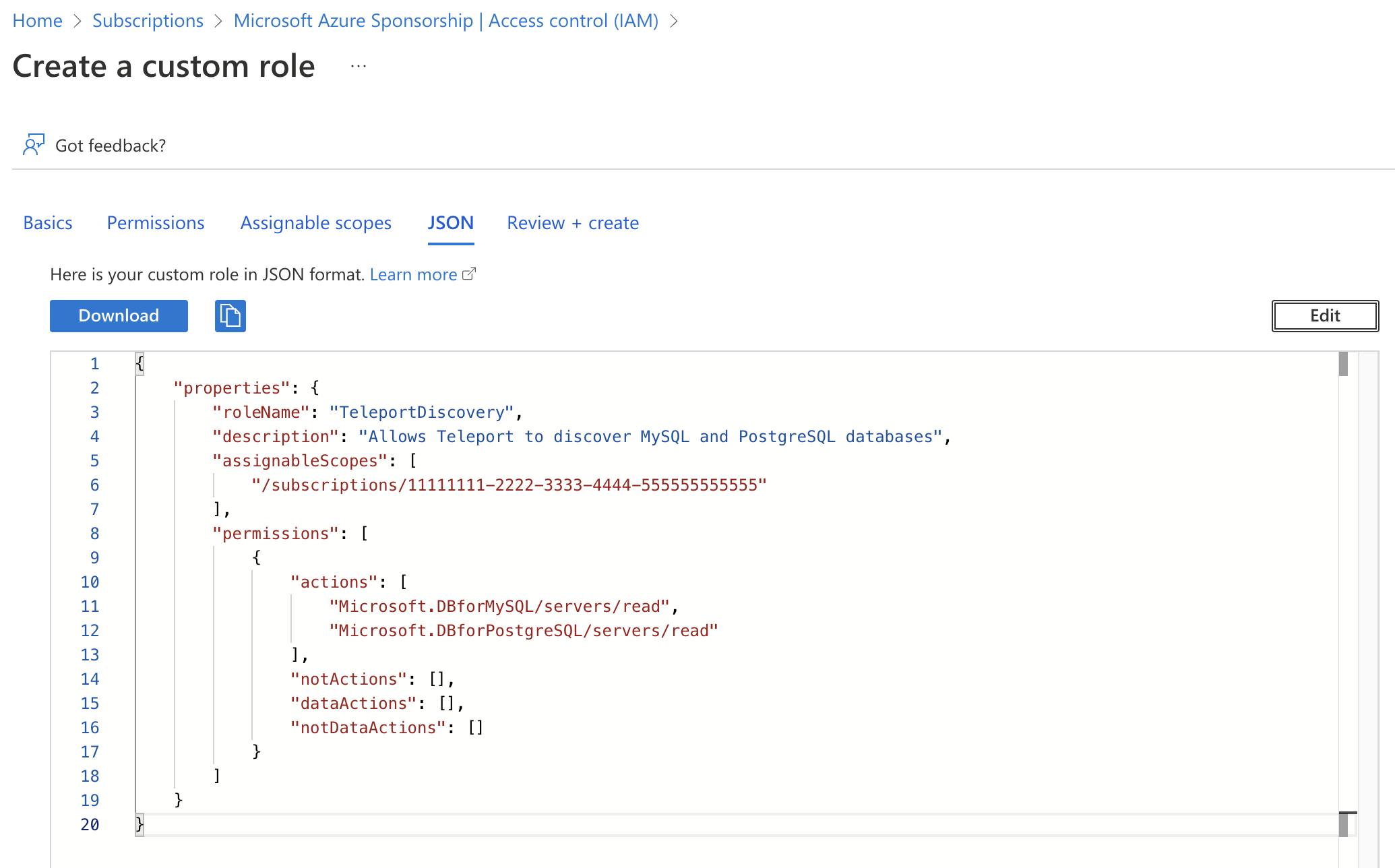
Create a role assignment for the Teleport Database Service principal
To grant Teleport permissions, the custom role you created must be assigned to the Teleport service principal - either the managed identity or the app registration you created earlier.
Navigate to the resource scope where you want to make the role assignment. Click Access control (IAM) and select Add > Add role assignment. Choose the custom role you created as the role and the Teleport service principal as a member.
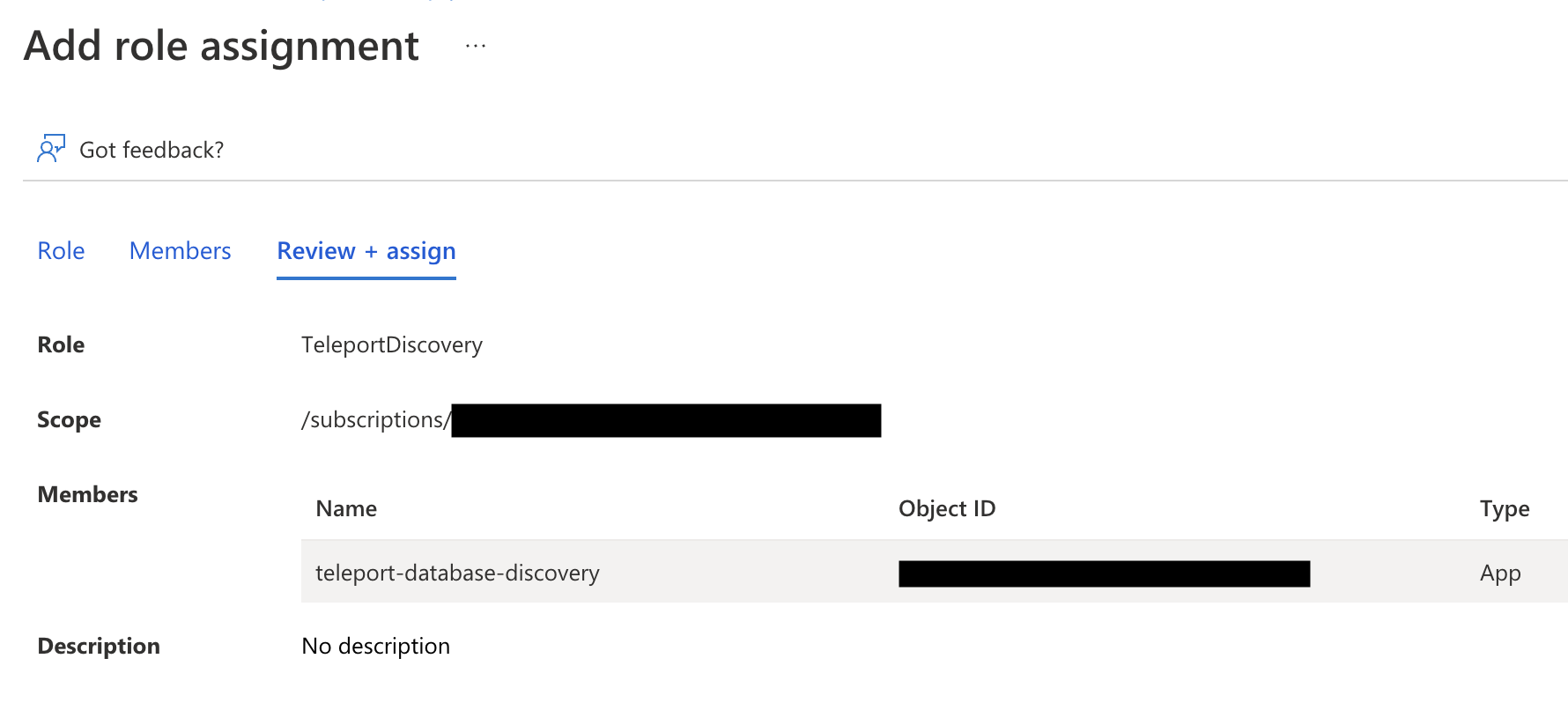
The role assignment should be at a high enough scope to allow the Teleport Database Service to discover all matching databases. See Identify the needed scope for more information about Azure scopes and creating role assignments.
Step 5/6. Create Azure database users
To let Teleport connect to your Azure database authenticating as a service principal, you need to create Azure AD users authenticated by that principal in the database.
Assign Azure AD administrator
Only the Azure AD administrator for the database can connect to it and create Azure AD users.
- MySQL Flexible
- PostgreSQL Flexible
- Single server
Go to your database's Authentication page and set the AD admin using the edit button:

Go to your database's Authentication page and set the AD admin by selecting + Add Azure AD Admins:
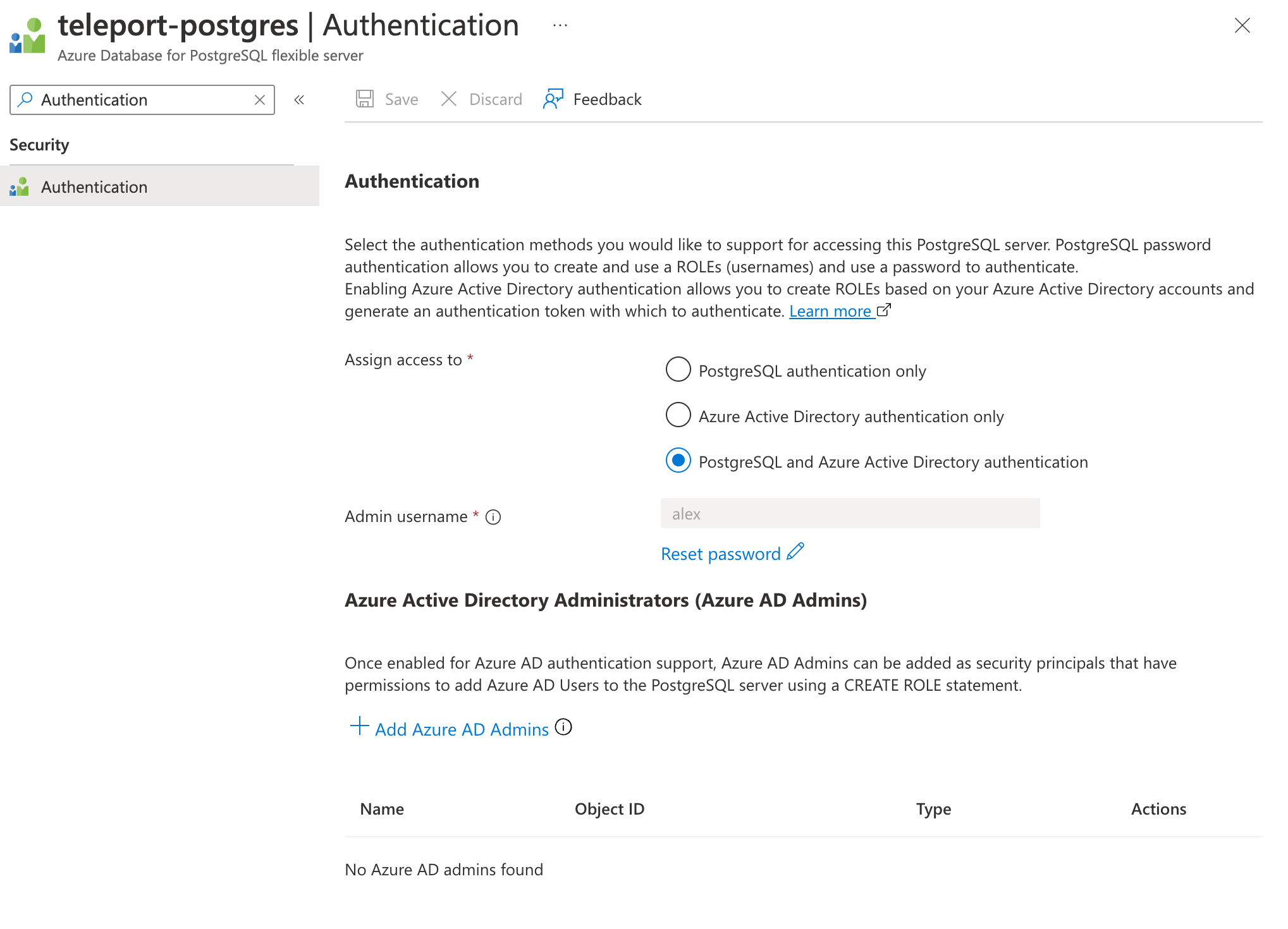
Go to your database's Active Directory admin page and set the AD admin using the Set admin button:

Only one Azure user (or group) can be set as an Azure AD admin for the database. If the Azure AD admin is removed from the server, all Azure AD logins will be disabled for the server. Adding a new Azure AD admin from the same tenant will re-enable Azure AD logins. Refer to Use Azure Active Directory for authenticating with PostgreSQL for more information.
Connect to the database as an AD admin
Next, you need to connect to your database as the AD admin user.
Use the Azure az CLI utility to log in as the user that you set as the AD admin,
fetch the access token and use it as a password when connecting to the database:
- PostgreSQL Flexible
- PostgreSQL
- MySQL Flexible
- MySQL
$ az login -u [email protected]
$ TOKEN=`az account get-access-token --resource-type oss-rdbms --output tsv --query accessToken`
$ PGPASSWORD=$TOKEN psql "host=example.postgres.database.azure.com [email protected] sslmode=require dbname=postgres"
$ az login -u [email protected]
$ TOKEN=`az account get-access-token --resource-type oss-rdbms --output tsv --query accessToken`
$ PGPASSWORD=$TOKEN psql "host=example.postgres.database.azure.com [email protected]@instance-name sslmode=require dbname=postgres"
$ az login -u [email protected]
$ TOKEN=`az account get-access-token --resource-type oss-rdbms --output tsv --query accessToken`
$ mysql -h example.mysql.database.azure.com -P 3306 -u [email protected] --enable-cleartext-plugin --password=$TOKEN
$ az login -u [email protected]
$ TOKEN=`az account get-access-token --resource-type oss-rdbms --output tsv --query accessToken`
$ mysql -h example.mysql.database.azure.com -P 3306 -u [email protected]@instance-name --enable-cleartext-plugin --password=$TOKEN
Note that the database username must include @instance-name suffix with the
name of the Azure database instance you're connecting to.
Create AD users
Once connected to the database as AD admin, create database users for the
service principal that Teleport Database Service will be using. Use Client ID
when using managed identities and Application (client) ID when using app
registrations:
- PostgreSQL
- PostgreSQL Flexible
- MySQL
postgres=> SET aad_validate_oids_in_tenant = off;
SET
postgres=> CREATE ROLE teleport WITH LOGIN PASSWORD '11111111-2222-3333-4444-555555555555' IN ROLE azure_ad_user;
CREATE ROLE
postgres=> SELECT * FROM pgaadauth_create_principal_with_oid('teleport', '11111111-2222-3333-4444-555555555555', 'service', false, false);
-------------------------------------
Created role for teleport
(1 row)
mysql> SET aad_auth_validate_oids_in_tenant = OFF;
mysql> CREATE AADUSER 'teleport' IDENTIFIED BY '11111111-2222-3333-4444-555555555555';
Query OK, 0 rows affected (0.92 sec)
The created user may not have access to anything by default so let's grant it some permissions:
GRANT ALL ON `%`.* TO 'teleport'@'%';
You can create multiple database users identified by the same service principal.
Step 6/6. Connect
Log in to your Teleport cluster. Your Azure database should appear in the list of available databases:
- Self-Hosted
- Teleport Enterprise Cloud
$ tsh login --proxy=teleport.example.com --user=alice
$ tsh db ls
# Name Description Labels
# -------- ------------------- -------
# azure-db env=dev
$ tsh login --proxy=mytenant.teleport.sh --user=alice
$ tsh db ls
# Name Description Labels
# -------- ------------------- -------
# azure-db env=dev
To retrieve credentials for a database and connect to it:
- MySQL
- PostgreSQL
$ tsh db connect --db-user=teleport azure-db
$ tsh db connect --db-user=teleport --db-name=postgres azure-db
The appropriate database command-line client (psql, mysql) should be
available in the PATH of the machine you're running tsh db connect from.
To log out of the database and remove credentials:
$ tsh db logout azure-db
Troubleshooting
No credential providers error
If you see the error DefaultAzureCredential: failed to acquire a token. in Database Service logs then Teleport
is not detecting the required credentials to connect to the Azure SDK. Check whether
the credentials have been applied in the machine running the Teleport Database Service and restart
the Teleport Database Service.
Refer to Azure SDK Authorization
for more information.
Timeout errors
The Teleport Database Service needs connectivity to your database endpoints. That may require
enabling inbound traffic on the database from the Database Service on the same VPC or routing rules from another VPC. Using the nc
program you can verify connections to databases:
$ nc -zv server-name.postgres.database.azure.com 5432
# Connection to server-name.postgres.database.azure.com 5432 port [tcp/postgresql] succeeded!
Unable to cancel a query
If you use a PostgreSQL cli client like psql, and you try to cancel a query
with ctrl+c, but it doesn't cancel the query, then you need to connect using a
tsh local proxy instead.
When psql cancels a query, it establishes a new connection without TLS
certificates, however Teleport requires TLS certificates not only for
authentication, but also to route database connections.
If you
enable TLS Routing in Teleport
then tsh db connect will automatically start a local proxy for every
connection.
Alternatively, you can connect via
Teleport Connect
which also uses a local proxy.
Otherwise, you need to start a tsh local proxy manually using tsh proxy db
and connect via the local proxy.
If you have already started a long-running query in a psql session that you
cannot cancel with ctrl+c, you can start a new client session to cancel that
query manually:
First, find the query's process identifier (PID):
SELECT pid,usename,backend_start,query FROM pg_stat_activity WHERE state = 'active';
Next, gracefully cancel the query using its PID. This will send a SIGINT signal to the postgres backend process for that query:
SELECT pg_cancel_backend(<PID>);
You should always try to gracefully terminate a query first, but if graceful cancellation is taking too long, then you can forcefully terminate the query instead. This will send a SIGTERM signal to the postgres backend process for that query:
SELECT pg_terminate_backend(<PID>);
See the PostgreSQL documentation on
admin functions
for more information about the pg_cancel_backend and pg_terminate_backend
functions.
Next steps
- Learn how to restrict access to certain users and databases.
- Learn more about dynamic database registration.
- View the High Availability (HA) guide.
- See the YAML configuration reference for updating dynamic resource matchers or static database definitions.
- Take a look at the full CLI reference.